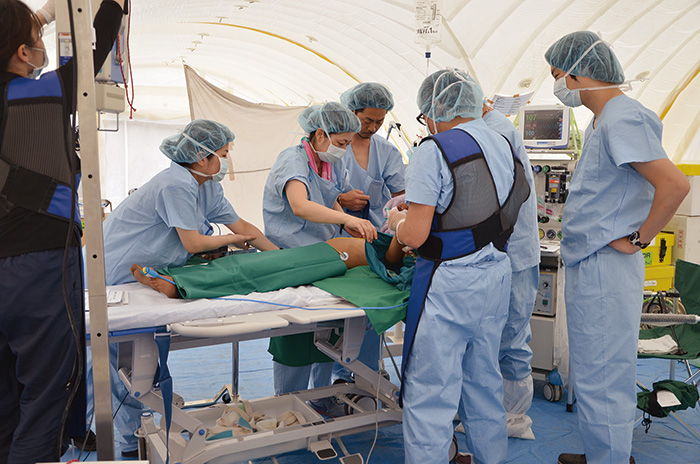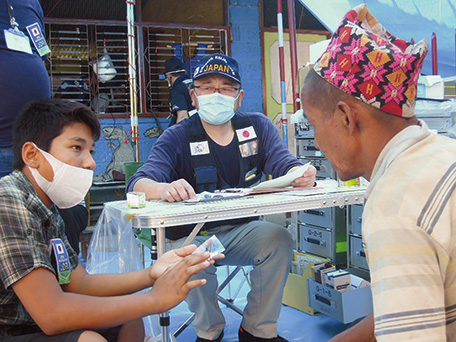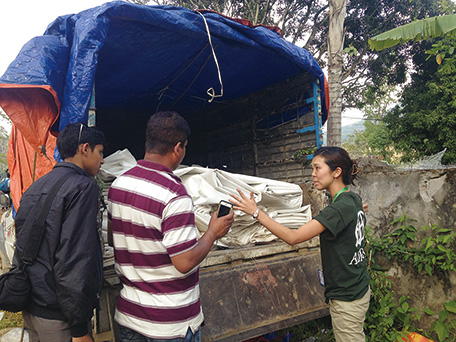ODA Topics 04
Large-Scale Natural Disasters and Emergency Humanitarian Assistance
– Dispatch of Japan Disaster Relief (JDR) Medical Teams in Response to the Earthquake Damage in Nepal and Activities by Japanese NGOs –
On April 25, 2015, around 12:00 pm (local time), a massive earthquake with a magnitude of 7.8 struck the mid-west part of Nepal and caused immense damage to Nepal and the neighboring countries. Japan, responding to a request from Nepal, provided emergency relief goods, such as tents and blankets, and supported relief activities implemented by international organizations and Japanese NGOs in the disaster-affected areas.

A medical team inside the surgery chamber. (Photo: JICA)

Members of the medical team provide a careful and thorough explanation about medicines to a patient via a young English-language volunteer interpreter. (Photo: JICA)

Aid provided by a Japanese NGO through the JPF (provision of waterproof materials for shelters in disaster areas). (Photo: ADRA Japan)
Furthermore, Japan dispatched Japan Disaster Relief (JDR) Teams (Search and Rescue Team, Medical Teams, and Japan Self-Defense Force Units) and provided emergency humanitarian assistance to those affected by the disaster. Below are some examples of activities implemented by the dispatched JDR Medical Teams in the disaster-affected areas and assistance initiatives carried out by Japanese NGOs.
The JDR Medical Teams are composed mainly of doctors, nurses, pharmacists and other medical personnel. This time, two medical teams composed of a total of 80 members were dispatched consecutively to the disaster-affected areas. In one of the most severely damaged areas in Nepal, the village of Bahrabise, which is located approximately 60 kilometers east of the capital Kathmandu, the JDR Medical teams set up a field hospital on the grounds of a junior high school, and engaged in medical relief activities.
These were the first medical teams equipped with facilities for surgical operations in the nearly 30-year history of JDR teams. The teams accepted patients with severe injuries that other medical teams active in the area were unable to treat. During the approximately four-week dispatch period, the medical teams examined and treated a total of approximately 980 patients and conducted surgical treatments for 12 patients. Prior to such treatments, the members of the JDR Medical Teams explained to patients and their families the treatment methods and post-surgery follow-up procedures with local doctors.
This approach was adopted in order to enable local medical personnel to continue treating patients after the JDR Medical Teams completed their mission in Nepal. In the case of an 8-year old boy who suffered a dislocation fracture of his left elbow, the doctors of the JDR Medical Team carefully and thoroughly explained the treatment procedures to his family through an interpreter before performing the surgery. The surgery was successful, but had it been delayed, the boy might have ended up with a disabled left arm. After the surgery, the smiles returned to the faces of the boy and his anxious father, who stayed by his side throughout the entire surgery.
For their activities, the JDR Medical Teams received letters of appreciation not only from the patients’ families and the Nepalese government, but also from the principal of the junior high school in Bahrabise, where their activity was based.
These activities carried out by the JDR Medical Teams in the affected areas were supported by many Nepalese people. For instance, the Ministry of Health and Population (the current Ministry of Health) of the Government of Nepal and the JDR Medical Teams maintained communication on a daily basis, consulting closely on specific details of their activities.
Moreover, doctors from health centers near the areas of the medical service activities offered their cooperation, enabling the JDR Medical Teams to work together with local medical facilities to provide assistance to those affected by the disaster. Also, local students helped act as interpreters and volunteers, serving as liaisons between JDR Medical Team members and patients who visited the field hospital.
Japanese NGOs also engaged in assistance activities in the disaster-affected areas. The Japan Platform (JPF), an emergency humanitarian aid organization established through a partnership among NGOs, the business community, and the government, utilized ODA funds to conduct assistance activities that responded to local needs mainly in the mountainous regions where the damages inflicted by the disaster were particularly severe. Specifically, they implemented the emergency restoration of water supply in order to secure water for domestic purposes for the people of Nepal and improve the hygienic environment, and provided assistance for the construction of temporary houses and school buildings before the start of the rainy season so that those affected by the disaster can live with a peace of mind.
Corrugated Galvanized Iron (CGI) sheets and other materials distributed by Japanese NGOs have been extremely useful in the construction of temporary warehouses to store precious food supplies. Also, the Asia Pacific Alliance for Disaster Management (A-PAD), which entered the disaster zone immediately after the earthquake, utilized ODA funds and cooperated with private sector medical teams from Bangladesh, to engage in medical relief activities in villages in areas not reached by the assistance efforts and to conduct search operations to rescue people buried under collapsed buildings using rescue dogs. The alliance leveraged its broad network and expertise to provide various forms of assistance.
In its responses to large-scale natural disasters throughout the years, the Japanese government has experienced both success and hardships. The lesson learned from these experiences is that self-righteously imposed assistance is counterproductive as it often brings chaos to disaster-affected areas, so countries providing assistance must maintain strong awareness of the necessity to always keep the countries affected by disasters at the center of the assistance efforts.
In order to avoid bringing further chaos to the already complicated situation in countries affected by natural disasters, and to deliver help and assistance to disaster-affected people as swiftly as possible, it is essential to take advantage of Japan’s strengths in providing such assistance, while collaborating with various organizations as necessary and providing assistance that is based on international coordination centered on the government of the disaster-affected country.
Going forward, the Japanese government will continue to provide seamless, swift and effective assistance in dealing with large scale natural disasters in all stages of the process, from emergency response to recovery and reconstruction.
